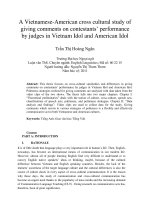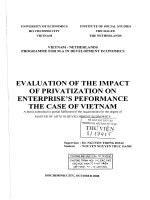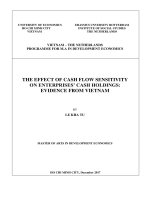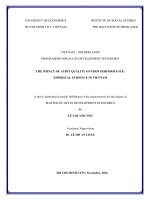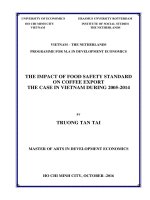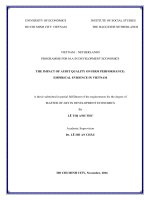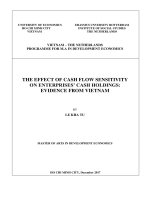Evaluation of the impact of privatization on enterprises performance the case of vietnam
Bạn đang xem bản rút gọn của tài liệu. Xem và tải ngay bản đầy đủ của tài liệu tại đây (2.72 MB, 85 trang )
UNIVERSITY OF ECONOMICS
INSTITUTE OF SOCIAL STUDIES
HO CHI MINH CITY
THE HAGUE
VIETNAM
THE NETHERLANDS
VIETNAM- NETHERLANDS
PROGRAMME FOR M.A IN DEVELOPMENT ECONOMICS
EVALUATION OF THE IMPACT
OF PRIVATIZATION ON
ENTERPRISE'S PEFORMANCE
THE CASE OF VIETNAM
A thesis submitted in partial fulfilment of the requirements for the degree of
MASTER OF ARTS IN DEVELOP.MENIECONOMICS
BQ GiAO .DVC.D.Ao
TRlfCiNG D,t..l HQC KINH r{TP.HC,
r.4-;---·
11-IU\liEN
r I /11tt a. r:-
Supervisor : Dr. NGUYEN TRONG HOAI
Student
: NGUYEN NGUYEN THUC OANH
TRUONG D~l HOC I
CAO HOC KINH Tl PHAT T~lt~
1/I~T N•M. t-
HOCHIMINH CITY, OCTOBER 2008
CERTIFICATION
"I certify that the substance of this thesis has not already been submitted for any degree and
has not been currently submitted for any other degree.
I certify that to the best of my knowledge and help received in preparing this thesis and all
sources used have been acknowledged in this thesis."
NGUYEN NGUYEN THUC OANH
Date: October, 2008
TABLE OF CONTENTS
Table of Content .................................................................................................................. i
Acknowledgements ........................................................................................................... iv
Abstract ............................................................................................................................... v
List of Abbreviations ........................................................................................................ vi
List of Tables ................................................................................................................... vii
List of Figures .................................................................................................................. vii
CHAPTER ONE: INTRODUCTION .............................................................................. !
1.1
Background and problem statement ........................................................................ 1
1.2
Research questions ................................................................................................... 2
1.3
Research methodology ............................................................................................. 2
1.4 Research objectives and hypotheses ....................................................................... .4
1.5
Research data ........................................................................................................... 4
1.6 Research units and scope of data ............................................................................ .4
1. 7
Structure of the study ............................................................................................... 4
CHAPTER TWO: LITERATURE REVIEW ................................................................. S
2.1
Introduction .............................................................................................................. 5
2.2
Privatization: history and definition ........................................................................ 5
2.2.1
History of privatization term ........................................................................ 5
2.2.2
Definition ..................................................................................................... 6
2.3
Privatization models ................................................................................................ 8
2.4
Objectives of privatization programs ....................................................................... 9
2.5
Privatization & Performance ................................................................................. 12
2.5.1
Fundamental economic theories ................................................................ 12
a. Property Rights .................................................................................... 12
b. Principal-Agent Problem or Agency relationship ............................... .14
2.5.2
Empirical evidences .................................................................................. 15
2.5.3
Summary ................................................................................................... 19
CHAPTER THREE: PRIVATIZATION PROCESS- THE CASE OF VIETNAM.21
3.1
"Equitization" terminology in Vietnam context .................................................... 22
3.2
Major characteristics of Vietnam's equitization program .................................... .22
3.3
Empirical studies for Privatization in Vietnam ...................................................... 27
3.4
Chapter remarks ..................................................................................................... 28
CHAPTER FOUR: RESEARCH METHODOLOGY ................................................. 29
4.1
Research hypotheses .............................................................................................. 29
4.2
Methodology selection ........................................................................................... 30
4.2.1
Impact valuation methods .......................................................................... 31
4.2.2
Multiple regressions ................................................................................... 32
4.3
Model design ......................................................................................................... 34
4.4
Sampling ................................................................................................................ 35
4.4.1
Description of data collection .................................................................... 35
4.4.2
Statistical data description ......................................................................... 35
a. Structure of the sample ........................................................................ 36
b. Size ofthe samples .............................................................................. 36
c. Ownership structure ............................................................................. 37
d. Equitization modes ............................................................................. 38
e. Listing status ........................................................................................ 38
f.
4.5
Corporate governance .......................................................................... 39
Chapter remarks ..................................................................................................... 40
CHAPTER FIVE: DATA ANALYSIS AND FINDINGS ........................................... .40
5.1
Introduction ............................................................................................................ 41
5.2
Results from the method of reflexive comparison ................................................ .4 2
5.2.1
Profitability ................................................................................................ 42
5.2.2
Output growth ............................................................................................ 47
5.2.3
Operating efficiency .................................................................................. 49
5.2.4
Leverage ..................................................................................................... 52
5.2.5
Employment and compensation ................................................................. 55
ii
5.2.6
5.3
Summary of impact valuation analyses .................................................... 58
Regression analysis ................................................................................................ 59
5.3.1
Profitability ,.............................................................................................. 59
5.3.2
Efficiency .................................................................................................. 60
5.3.3
Leverage ..................................................................................................... 60
5.3.4
Summary of regressions analyses .............................................................. 60
CHAPTER SIX: CONCLUSIONS AND POLICY IMPLICATIONS ....................... 61
6.1
Conclusions and policy implications from impact valuation ................................. 62
6.2
Conclusions and policy implications from OLS regressions ................................. 64
6.3
Research limitations ............................................................................................... 65
REFERENCES ................................................................................................................. 67
APPENDICES .................................................................................................................. 73
lll
•
ACKNOWLEDGMENTS
These acknowledgments must begin with, and I cannot thank enough, Dr. Nguyen Trong
Hoai, my supervisor, for scientific instructions and encouragements to undertake this
project. Behind my efforts are my parents, sister and husband whose daily patience,
sympathies and encouragements were very essential. I wish to express my enormous love
and appreciation to my parents who have tacitly and unconditionally created the best
conditions for me and to my husband who has shared with me the highs and lows in
preparation of the thesis. I am also grateful to several friends for providing the data as well
as valuable ideas and comments.
IV
ABSTRACT
This paper studies impacts of equitization on firm operating performance in Vietnam.
By comparing financial results of 38 enterprises equitized in 2005 and early 2006 in pre
and post privatization periods, the study has found dramatic increases in profitability and
efficiency as well as sharp declines in leverage following equitization. Unexpectedly, gains
in output growth and decreases in employments are statistically insignificant.
Nevertheless, it is difficult to conclude that those improvements are sole impacts of
equitization since the study is unable to control concurrent effects of structural reforms and
economy-wide changes that are frequently encountered in the transition economies like
Vietnam. Notwithstanding the vague answer on impacts of equitization, the author gives
favors to equitization in the sense of creating incentives for managers, in tum, encouraging
them to be more focused on improved profit and efficiency targets.
From multiple regression analyses, the study points out determinants of changes in
profitability and leverage including listing status, firm size, directorship changes, and
privatization modes. The OLS analyses lead to implications that the government should
strengthen its managements over equitization process, impose mandatory requirements on
getting listed after equitization, promote directorship replacements, reduce its holdings or
shift the representative role of relevant authorities to State Capital Investment Corporation.
v
ABBREVIATIONS
BOD
: Board of Directors
CEO
: Chief Executive Officer
ClEM
: Central Institute for Economic Management
CPI
: Consumer Price Index
HASTC
: Hanoi Securities Trading Center
HOSE
: Ho Chi Minh Stock Exchange
IPO
: Initial Public Offerings
OLS
: Ordinary Least Square
SCIC
: State Capital Investment Corporation
SIP
: Share Issuance Privatization
SOE
: State Owned Enterprise
TVEs
: Township and villages owned enterprises
VND
: Vietnam Currency
vi
LIST OF TABLES
Table 2.1: Various Privatization models .............................................................................. 9
Table 2.2: Summary of financial indicators used in MNR approach ................................ 15
Table 3.1: Number of equitized firms and average ownership structure in 1992- 2006 .. 26
Table 4.3: Summary ofthe hypotheses for impact valuation ............................................ 30
Table 4.1: Variables' definitions and their expected signs ............................................... .33
Table 4.2: Variables' definitions and their expected signs ................................................ 34
Table 4.4: Size of samples ................................................................................................. 36
Table 4.5: Ownership structure .......................................................................................... 37
Table 4.6: Equitization modes ........................................................................................... 38
Table 4.7: Structure of Directors ....................................................................................... 39
Table 5.1: Tests of predictions for profitability of equitized firms .................................. .45
Table 5.2: Tests of predictions for output growth of equitized firms ............................... .48
Table 5.3: Tests ofpredictions for efficiency ofequitized firms ....................................... 50
Table 5.4: Tests of predictions for leverage of equitized firms ......................................... 53
Table 5.5: Tests of predictions for employment and compensation of equitized firms ..... 56
Table 5.6: Regression results ............................................................................................. 59
LIST OF FIGURES
Figure 2.1: Three layers of privatization definition ............................................................. 7
Figure 4.1: Structure of samples by sectors and regions ................................................... 36
Figure 4.2: Listing status ................................................................................................... 38
Figure 4.3: Roles of non-executive BoD members ........................................................... .39
vii
•
CHAPTER ONE
INTRODUCTION
1.1. Background and problem statement
Privatization has been widely promoted as a mean of restructuring the economy in
both developed and developing countries from 1980s. The program has been launched
under expectation to create long term benefits to both firm and entire economy levels. Over
two decades since Thatcher's government first introduced modem policy of privatization
have provided efficient time for researchers building up theoretical frameworks as well as
empirical evidences for privatization outcomes. Nevertheless, nowadays, impacts of
privatization remain one of the most controversial economic issues. Recent reviews of
impacts of privatization have shown the favor to privatization as an important tools to help
allocate resources, restructure the economy and then facilitate the economic growth. In
contrast, there are some authors pointing out some failure evidences and drastically
criticizing methodologies employed to generate these conclusions. They argue that
performance changes may be mixed effects of privatization and contemporaneous events
including more macroeconomic stability, fiscal prudence, freer capital movements,
promotion of competition and regulatory changes (Parker and Kirkpatrick, 2005).
Following the international trend, Vietnam launched the privatization program m
1992 as a major part of State-Owned Enterprise (SOE) Reform Program. Privatization
program, called as "equitization" in Vietnam, is an interesting case when the state retains
the voting control and holdings of insiders are fairly substantial. From theoretical point for
view, performance of a privatized firm where the state remains the controlling role is not
far different from that of a SOE (Boycko et al., 1996). Therefore, the program outcomes
remain in question.
Unfortunately, the equitization program has been executed for over ten years, though,
till now there are a limited number of empirical studies to evaluate appropriately the
consequences of the program except reports of ClEM (2002 and 2005) and Truong et al.
(2003 and 2007). ClEM studies report improved firm's performance following equitization
by using descriptive analysis on 256 equitized firms across Vietnam during 1992 and 2003.
However, the studies have not come to a clear conclusion that changes are the sole impact
of equitization. Whereas, Truong et al. (2007) using data of 92 SOEs and 147 equitized
firms in southern provinces indicate positive impacts of equitization on firm's operating
performance. By employing a hybrid methodology, the latter study not only controls
concurrent effects of structural reforms but also points out determinants of performance
changes which include firm size, ownership, listing status, location and corporate
governance.
However, because most of firms selected for studies of ClEM (2002 and 2005) and
Truong et al. (2003 and 2007) had been equitized before 2003, they have brought the
characteristics of the program in the early stage, which are small firm size, low state
concentration and high participation of workers. These studies could be seriously suffered
from endogenous bias as just firms, with profitable and growth potential, were selected to
be equitized. Therefore, their conclusions somewhat can not reflect the outcomes of whole
equitization program in general and the latter stage, which is featured by larger firm size,
high state concentration and high involvement of outsiders, in particular. For that reason, it
is necessary to conduct a research with a different observation base in order to evaluate
impact of equitization on SOEs participating in it during the accelerating stage in terms of
operating performance. This study aims at investigating the effects of equitization on the
performance of newly equitized companies in Vietnam regarding to profitability,
efficiency, leverage, and employment and compensation.
1.2. Research questions
The questions will be answer in this study are ( 1) whether or not there is any positive
impacts of equitization on the operational performance of newly equitized firms in Vietnam
in the accelerating stage; and (2) What are the determinants of changes in equitized firm's
operational performance?
1.3. Research methodology
Descriptive analysis, reflexive comparison and multiple regressions are three methods
employed in this study. While the description is used to provide the structure of the
database and describe the concern issues, reflexive comparison, which is widely known as
an approach ofMeggison, Nash and Randenborgh (1994) (henceforth MNR), is to evaluate
2
impacts of equitization on firm's operating performances. This method measures the effects
of equitization by making subtraction of financial indicators between before and after
equitization times of the program participants. In addition, to test the statistical significance
of the differences in performance indicators between two periods, two tailed Wilcoxon
signed rank test is applied. Finally, we adopt multiple OLS regressions to test hypotheses
on determinants of operational performance changes following equitization.
1.4. Research objectives and hypotheses
The major objectives of this study are (1) to assess the impact of equitization on the
firm operating performance; and (2) to test determinants of performance changes following
equitization. We examine firm's operational performance through five aspects which are
profitability, efficiency, output growth rate, leverage and employment and compensation.
The study has six hypotheses which are separated into two folds. Firstly, for accessing
impacts of equitization, there are four hypotheses as followed
(1) It is expected that equitization will ead to improved profitability and efficiency;
(2) Going along improved efficiency, equitization is expected to stimulate
investments and therefore, new growth;
(3) Debt level is projected to decline in response to equitiation;
(4) Number of employees are also forecasted to decrease as the managers now shift
from political or social goals to profit and efficiency maximization, which
implies, in turn, an increase in employee's incomes;
Secondly, followings are two hypotheses for identifying causal factors ofthe changes
in firm's performance after equitization.
(5) Profitability and efficiency: it is expected that listing status and directorate
replacements have positive relationships with differences in profitability and
efficiency while state ownership and firm size have negative effects after
equitization.
3
(6) Leverage: state ownership is projected to have positive impacts on leverage
declines the post equitization period whereas listing status, directorship changes
and the model of share issuance privatization are positive determinants.
1.5. Research data
The data are extracted from firm's IPO prospectuses and annual reports which are
obtained by various ways.
1.6. Research units and scope of data
This study only focuses on SOEs equitized in 2005 across Vietnam. However, the
research unit has some restrictions due to limited data access. First, on the sector front, the
dataset covers all available sectors but except to traffic construction. Second, the
equitization form of "splitting a subsidiary or factory from an existing State Corporation
Company and selling parts or all of it" is out of scope of this study. Third, the study
excludes firms governed by provincial authorities except Ho Chi Minh City government.
1.7. Structure ofthe study
The study consists of six chapters. Beside the first chapter with introduction, the
second one is to review the literature on privatization. The next chapter provides brief
introduction about Vietnam equitization program and its outstanding characteristics. The
fourth chapter presents the methodology framework and describes the data used in this
study. The empirical results are presented and discussed in chapter five. The final one then
provides the conclusion of the study and policy implications as well as outlines some
limitations.
4
CHAPTER TWO
LITERATURE REVIEW
2.1
Introduction
The major purpose of this chapter is to review theoretical and empirical literature for
impacts of economic performance with a focus on firm-level analysis to provide a backdrop
for establishing the study framework. The chapter is organized five folds. The section one
deals with chapter introduction. Section two provides a brief history and definition of
privatization. Section three presents various forms of privatization. The fourth one aims to
address the questions: why privatization? What the initial objectives of governments when
embracing the privatization program? The final section is to provide reviews of the
relationship between privatization and firm-level performance.
2.2
Privatization: history and definition
2.2.1 History of privatization term
Many economists have believed that Drucker (1969) first coined the term
"reprivatization" in the late 1960s 1. However, Bel (2006) argues that privatization is not
originated from Druker. He points out that the terms "privatize" and "reprivatize" actually
appeared in the 1930s by German government under Nazi Economic Policy and recurred in
late 1950s in the case of automobile firm, Volkswagen.
After that, two terms "privatize" and "re-privatization" were defined clearly in 1961
edition of Webster Dictionary as 'to alter the status of (a business or industry) from public
to private control or ownership' and " the act or action of privatizing again: restoration to
private ownership and control (as after nationalization)" respectively. Nevertheless, English
scholars in the 1960s used privatization and denationalization synonymously as the sale of
a government-owned firm to the private sector (Bel, 2006). The story hadn't changed not
until Margaret Thatcher times. According to Bel (2006), Margaret Thatcher preferred the
term "privatization" because "denationalization" have sounded "ownership we being
surrendered to foreigners" and "had a negative and unappealing connotation". After the
1
Cited from Bel (2006)
5
sales of British Aerospace and Cable & Wireless in 1981 and British Telecom in 1984,
privatization becomes more friendly name and popular in Great Britain. According to
William Megginson (2000), privatization has been truly globalized in the mid 1980s and
early 1990s when over 100 countries in Western Europe, South and East Asia, Latin
America, Eastern Europe and sub-Sahara Africa adopted that term for their reform policies.
2.2.2 Definition
Privatization has various definitions. Normally, it depends on authors' targets or
policy marker's objectives. Many authors, such as Megginson et al (1994), Boubakri and
Cosset (1998), Omran (undated), Porta and Lopez-de-Silanes (1994), Harper (2000),
Truong et al. (2007) and so on, employ privatization narrowly, the sales of SOEs to the
private sector or the transfer of ownership from state to new owners. Boycko and Shleifer
(1996) define privatization as "combination of the reallocation of control rights over
employment from politicians to mangers and the increase in cash flow ownership of
managers and private investors". Accordingly, privatization must be associated with
completed transference of voting control from public to private hand. Ramamurti (2000)
views privatization as "the transfer of some or all of ownership and/or control over SOEs to
private sector". According to World Bank (1991), privatization is "the model of divestiture
of the state enterprises".
However, some authors argue that privatization should be viewed as broad meanings
since they believe that using narrow meanings potentially causes misleading. The reason is
concurrent effects of structural reforms and possibility of missing record due to application
of various privatization models. For examples, privatization could be occurred under the
form of "contracting out of publicly financed services, which previously performed by
public sector organizations, to the private sector" (Vicker and Yarrow, 1991). Moreover,
according to several researchers like Cook and Kirkpatrick (2004) and Ramamurti (2000),
privatization does not always transfer resources from public to private ownership; it also
implies "increases the role of the private sector in the economy". The privatization of SOEs
should be coordinated with embracing deregulation, economic liberalization, strengthening
institutions.
6
To a larger extent, Pack (1987) emphasizes the role of public functions. In Park's
view, there are three areas for privatization comprising of finance, production and
regulation. By these means, government diversifies privatization forms, clarifies public
functions, maintains essential public goods and promotes deregulation to support private
sector. From that point of view, Pack (1987), hence, designs three principal forms of
privatization: (1) divestiture or devolution of the public function under the form of
contracting out some public services, (2) maintaining public finance but shifting the locus
of production from the public to the private sector, (3) deregulation.
In sum, privatization can be understood from three levels as presented in figure 2.1.
The simplest meaning is the sales of state-owned assets to private. The second level is the
transfer of the operations of state-owned assets to private entrepreneurs such as contracting
out. The broadest one is market liberalization, liberalization of prices and trade, and
encouraging competition in an economy.
Figure 2.1: Three layers of privatization definition
Market liberalization, liberalization of prices and trade, and
encouraging competition in an economy
Transfer of the operations of state-owned assets to
private entrepreneurs, such as contracting out
I
Sales of state-owned assets to private
I
Source: Stifanos (2000/
Empirically, China has introduced its privatization program as a tool not only to
restructure the economy but also to create private property and the institutions of a market
economy. The program aims at ensuring a maximization of economic growth and a
minimization of social, economic, and political disorder (Lan Cao, 2000). Chinese
privatization program, so called "privatization with Chinese characteristics", is a
combination between traditional privatization and China characteristics which is excessive
population. Chinese program emphasizes not the immediate privatization of the state sector
as the traditional model of Russia & Europe but rather retention of the state sector with
2
Cited from Debessay (2004)
7
concomitant creation of a parallel non-state sector designed to supplement the state sector
and to serve as a social shock observers in the event that the state sector itself to be
eventually "privatize" (Lan Cao, 2000).
2.3
Privatization models
Savas (1992) presents a comprehensive classification of privatization models.
Although the paper is in the context of post - socialist countries, his taxonomy is rather
broad and systematic. Brada (1996) also has synthesized four methods of privatization
encompassing restitution, sale of state property, mass or voucher and privatization from
below. However, these methods directly or indirectly belong to three broad strategies of
Savas (1992). He classifies privatization of SOEs in three broad categories: divestment,
displacement and delegation. Each includes several forms that are presented in table 2.1.
Divestment is more focused on forms of ownership transfer while displacement and
delegation is more related to institutional changes or in broad definition manner.
Descriptions of displacement & delegation will be skipped because they are beyond the
scope ofthis study.
The first form of divestment is sales of a government enterprise to one or five types of
buyers. Selling government assets to a sole buyer normally happens in post-socialist
countries and results in joint-ventures if the state captures some stakes in order to avoid
painful effects of liquidation. A SOE can be sold partially or in stages in order to avoid
swamping the capital markets, or sold to the public through Initial Public Offerings (IPO),
managers, all employees and their users or customers. For example, the IPO was used in
Great Britain to sell British Telecommunications, Jaguar or National Freight Corporation
.... In post-socialist countries, employees bought share at a discount price. However, Savas
(1992) is criticized when he believe that most enterprises in post-socialist countries cannot
be sold to the public due to poor performance and tenuous future.
The second form of divestment is free transfer. Under this model, the enterprise is
offered for free to employees, users or customers, the public and the original owners
(restitution). Free transfer took place in England for English Channel hovercraft ferry
service, in Kenya for local water systems and in Canada. Divestment in the form of free
transfer to employees, customers or the public is known as mass or voucher privatization in
8
Central and Western Europe. Citizens can use vouchers distributed free or at nominal cost
to bid shares of privatized SOEs. Savas (1992) indicates that restitution is more feasible in
Eastern Europe where nationalization was about 45 years ago. Restitution rarely happens
where expropriation occurred more than 70 years old or wasn't recorded. Restitution also
becomes problematic where pre-expropriated social structure was too complicated with
relatively few wealthy owners, small middle class and many poor like China.
Table 2.1: Various Privatization models
Divestment
Sales
I. to private buyers (by auction, seal bid, or negotiation)
2. to public (by sale of shares)
3. to management
4. to all employees
5. to users or customers
Free Transfer
1. to employess (and/or their pension fund)
2. to users or customers
3. to the public
4. to the original ower (restitution)
Liquidation
Displacement
Default
Withdraw
Delegation
Contract
Franchise
1. public domain (concession)
2. public assets (lease)
Source: Savas (1992)
Liquidation is the final form of divestment. Savas (1992) classifies liquidation as a
form of privatization because he considers it as a transfer of government assets to private
sector at a zero price. This occurs in enterprises that have poor performance or gloomy
outlook. He denotes that liquidation carried out popularly in former East Germany.
Furthermore, he indicates that is inevitable form in all post-socialist countries.
2.4
Objectives of privatization programs
9
It is useful to understand why governments are concerned about privatization by
asking what's wrong with public enterprises and what the major reason is. Many
researchers, such as Boycko, Shleifer and Vishny (1993 and 1998) and Vickers and Yarrow
(1991) and so on, believe that public enterprises are inefficient. Over employment,
manufacturing non-marketable goods, locating economically inefficient places, and
outdated capital stock are their major causal problems.
The starting point for inefficiency is the enterprises' targets or owners' objectives.
From standard public finance point of view, governments use public enterprises to achieve
social and political objectives such as social welfare, security, industrial policies rather than
efficiency and profit maximization (Boycko, Shleifer and Vishny, 1998). For instance,
Russian SOEs produced military goods when the communist government wanted to secure
the government existence and pursue cold war against capitalists. Boycko et a!. (1998)
denote that "Politicians care about votes of the people whose jobs in danger and in many
cases; and unions have significant influence on political parties". Therefore, excess
employment is a chronic characteristic of state-owned firms and the most commonly noted
one. For examples, the British government for a long time declined to close grossly
inefficient coal mines to preserve mining jobs. Moreover, state-owned companies are also
considered as a mean for government bureaucrat to pursue his or her personal agenda.
According to Vickers and Yarrow (1991 ), personal agenda includes redistribution to
favored interest groups, high wage, employment levels in particular enterprises or sectors,
and patronage and so on. The money losing in Credit Lyonnais is a concrete example,
Boycko et al. (1998) quote. The French state-owned bank made it worst loans to the friends
of the governing socialist party.
In order to convince managers to shift from profit maximizing to social and political
objectives, politicians subsidies firms, especially loss-making ones. In return, managers
hire extra people and locate economically inefficient placesS. Boycko et al. (1993) describe
the relationship between politicians and firms' managers as a bargain when managers come
to beg for financing. Finally, such payments from governments to firms lead soft budget
constraints which, in tum, create three consequences: (1) diminishing the firm's sensitivity
towards interest rate and exchange rate and so on, (2) reducing ability of dynamic
adjustment and, (3) excess demand for inputs especially investment.
10
On the government side, that the state has subsidized for state-owned enterprises for a
long time causes substantial budget deficit and inefficient resource allocation. In turn, such
persistent deficit probably leads to crowding-out effects and raising external debts. Budget
deficit was a common phenomenon in both rich and poor countries in late 1980s. For
examples, in 1975, financial deficit in Great Britain amounted to over 35 percent of the
state-owned enterprises' contribution to GDP.
Ramamurti (1992) points out that there is a positive correlation between budget
deficit and privatization. Privatization countries have higher budget deficit than nonprivatizing countries, and budget deficits so seem to increase the possibilities that a country
will privatize. Additionally, he comes to a conclusion that financing budget deficit by
external borrowings heightens the odds of privatization in comparison with domestic
borrowings. In general, governments have concerned about privatization as targets to
promote efficiency and reduce the budget deficit.
Empirically, the UK government hasn't proposed comprehensive objectives for its
privatization program as a whole. The goals of the program have changed over times and
differed from ministers. Yarrow (1986) summaries into a list of goals over stages as
followed: (1) improving efficiency by increasing competition and allowing firms to borrow
from the capital market, (2) reducing the public sector borrowing requirement, (3) easing
problems of public sector pay determination, (4) reducing government involvement in
enterprise decision making, (5) widening the ownership of economic assets, (6)
encouraging employee ownership of shares in their companies, and (7) redistributing
income and wealth.
Regarding to privatization program in Russia, besides objectives mentioned above the
government also aims to gain support from reformist's politicians. Boycko el al. (1993)
argue that by privatization Russian government's target is to mitigate painful effects caused
by price liberalization, monetary tightening, employment cut and reduction of government
spending. To a larger extent, privatization in Central and East Europe has been focuses on
four key objectives comprising introducing a market economy, increasing economic
efficiency, establishing democracy and guaranteeing political freedoms and increasing
government revenue (Dhanji and Milanovic, 1991).
11
Contrary to Russia and other countries in Central East Europe, many researchers
believe that in China, external factors including property rights reforms, market
development, changes in institutional environment and increase in market competitiveness
force local governments to choose privatization to avoid shut down of township and
villages owned enterprises (TVEs) rather internal factors like inefficiencies or budget
deficit. By using firm level panel data collected in 11 cities in the period 1995 - 2001, Guo
and Yao (2004) find out that causes of privatization in China comprise of market
liberalization, hardened budget constrained and the financial position of local government.
Privatization is constrained by excessive debt and redundant workforce. Market
liberalization intensifies the competition faced by TVEs and hardened budget constraint
makes TVEs difficult for financing sources from banks. Bank reform from 1994 insulates
local banks from the influence of local politicians and shifts the lending rights to upper
level branches. Although large budget can cause a delay in privatization but once the
decision is made, it alleviates the constraint of excessive debts. Surprisingly, efficiency is
not a factor in consideration. These researchers find out that efficiency is not a concern in
local government's decision of privatization when an unprofitable firm may still deliver
taxes to the government and maintain sizable employment.
2.5
Privatization & Performance
2.5.1 Fundamental economic theories
Currently, a large number of theoretical and empirical studies have analyzed the role
of privatization program with a main focus on whether privatization program have induced
a positive impact on the company performance or not. On a theoretical aspect, two methods
are employed, comprising property rights and principal-agent. Both theories claim that
firms under private property rights are more efficient than state ownership.
a. Property Rights
The property rights approach points out the differences between public and private
firms on how to use the resources under the conditions of scare resources, positive
transaction cost and existence of Pareto optimal principal. The core idea of this theory stays
at exclusive and transferable characteristic of resources owned. From that point of view,
Alessi (1987) points out to two reasons that lead to inefficiency at SOEs. First, lacks of
12
•
exclusive and transferable rights to use the resource does not encourage managers at SOEs
allocate resources efficiently. Second, deriving from non transferable feature of public
assets, public managers have less incentive to take into account the market conditions. In
placement, they take advantage of political power to seek the subsidies and regulatory
protection from competitive forces. Therefore, Alessi ( 1997) concludes that "a careful
program of privatization would result in higher output and welfare".
The property rights are rights of individual to use resources, earn mcome from
resources and transfer resources to others. These rights are defined and enforced not only
by government rules but also social custom. The costs of defining, monitoring and
enforcing of property rights are termed as transaction costs.
According to property rights theory, the effectiveness of the market in relieving
scarcity is closely tied to the extent to which property rights are privately held. Under
private ownership form, the resources are exclusive and transferable to others at the
agreeable price. Alessi (1997)'s major argument is that private property allows resources
owners be flexible in resources allocation to gain maximum profit after they take into
account all harms and benefits. Ultimately, the current transfer price reflects fully the future
consequences. However, the existence of positive transaction costs may reduce individuals'
incentives to fully take into account harms and benefit in their decisions. Alessi (1987)
argues that these costs constrain to yield new efficient solutions. Therefore, to economize
transaction costs, the market appears. The market is the place for a low-cost arrangement
for facilitating specialization and exchange. These arguments suggest that private
ownership is equal with profit maximization. Meanwhile under state ownership, individuals
lack exclusive and transferable rights to use the resources. Thus they have less incentive to
conserve and improve them.
Furthermore, Alessi (1987) points out that the distinguishing characteristic of political
firms is the high cost of transferring ownership rights in their specialized assets because the
property rights in political firms are nontransferable. This feature inhibits capitalization of
future consequence into the current price and reduces the extent to which individuals bear
•
the value consequences of their decisions. Outcome of government ownership is that the
public managers are less incentive to take the market condition into consideration as they
13
find it easier to receive subsidies. Moreover, they have opportunity to manipulate the state
power, seeking protection from government to fight against competitive forces. Alessi
( 1987) criticizes political firms mask their goals under the guise of fulfilling social targets.
As a result, government involvement in production of goods and services as well as the
regulation of business activity is main culprit of market failures and distributive problems
such as monopoly, public goods, and externalities.
b. Principal-agent problem or agency relationship
Another useful approach for efficiency analysis of privatization is principal-agent
theory. This approach is based on different agency problems and availability of solutions to
them that are associated with each form of ownership (Villalonga, 1999). Principal-agent
problems occur in both the public and private ownership. However, it is considered that
private ownership structure yields better solutions against these problems; hence, it leads to
better efficiency.
The principal-agent problems are defined as conflicts of interest in the agency
relation. The problem arises when the agents (such as mangers) may not act in the best
interests of the principals (such as owners). Two problems of agency relation comprise of
hiring the right agents and knowing that they will do the job appropriately which are known
as adverse selection and moral hazard respectively (Tuhaika, 2007).
Both types of firm have to face with these problems but it is argued that private firms
play a better role in mitigating these affects and produce a superior efficiency. Nellis (1994)
and Villalonga ( 1999) justifies five reasons for greater performance of private firms: ( 1)
there is a market for managers which enables the owners to find higher quality managers
(2) existence of ownership rights allows the owners sell their the rights if they are not
satisfied with managerial performance or want to withdraw from the market at a agreed
price- actually, this is a focus of Property Rights theory; (3) The threat of bankruptcy and
takeover - these threats create incentives that owners and managers will take active and
enhance efficiency to avoid it; (4) Less intervention from politician: higher transaction
costs discourage politicians from interfering into firm operation to pursue social objectives
or their personal target (5) Harder budget constraint suggests private firm to have greater
14
scrutiny and discipline while public enterprises obtain supports from the state both in
finance and regulation.
From this point of view, there are the arguments that governments can mitigate
agency problems by establishing and maintaining commercial targets in stead of non
commercial ones (Nellis, 1994). They can impose harder budget constraint, recruit qualified
managers from the market and give autonomy to public enterprise managers to achieve
commercial aims. However, commitments to the priority of commercial aims or
noninterference in daily management are rather fragile. When the crisis fades, or when the
regime changes, or when some major political claim arises, those commitments fades with
it.
2.5.2 Empirical evidences
Currently, numerous researchers have assessed the impacts of privatization program
on operating performance of privatized enterprises and macroeconomic status by various
methodologies. Most of researchers have reported a positive relationship between
privatization and efficiency improvement, including Megginson and Netton (2001),
Boubakri and Cosset (1998), Megginson, Nash and Randenborgh (1994), Porta and Lopezde-Silanes (1997), Bai, Lu and Tao (2005) and Harper (2000).
Table 2.2: Summary of financial indicators used in MNR approach
Proxies
Return on Sales =Net Income/Sales
Profitability
Return on Assets =Net Income/Total Assets
Return on Equity =Net Income/Equity
Real Sales = Nominal Sales/Consumer Price Index
Output
Sales Efficiency = Sales/Number of Employees
Operating Efficiency
Net Income Efficiency= Net Income/Number of Employees
Long-term Debt to Equity = Long term Debt to Equity
Leverage
Capital Expenditures to Sales = Capital Expenditures/Sales
Capital Investment
Capital Expenditures to Assets = Capital Expenditures/Assets
Employment
Total Employment= Total Number of Employees
Dividend to Sales = Cash Dividends/Sales
Payout
Dividend Payout= Cash Dividend/Net Incomes
Characteristics
Source: Megginson eta/. (1994)
15
Megginson, Nash and Randenborgh (1994) compare pre and post financial and
operating efficiency of privatized firms. The MNR study covers a large sample size
including 61 companies ranging from 18 countries and 32 industries which are full or
partial privatization through initial public offerings during 1961 and 1990. To measure
operating results of surveyed firms in terms of profitability, operating efficiency, capital
investment, output, employment, leverage and payout, these authors employ empirical
proxies as presented in table 2.2. Then they calculate the mean of each proxy for each firm
over post and pre privatization periods. After that, Wilcoxon signed rank test is used to test
significant changes in the proxies.
Megginson et al. (1994) present strong evidences of a significant increase in
profitability, output, capital spending and workforce; improvement in operating efficiency
and a decline in leverage of firms after privatization. Interestingly, the study also shows a
remarkable performance improvement in both full and partial government divestments and
insignificant differences between competitive and non-competitive firms. These authors
report greater improvement for the group of firms that have dramatic changes in
directorship after privatization. However, because of data and methodology limitations,
they can not determine the causal factors of performance changes after divestment.
On the other side, Boubakri and Cosset (1998) criticize that MNR conclusion can not
be a representative for the developing world when sample firms from developing countries
are relatively small (from three to twelve, depending on the financial and operating
performance measure). Economic circumstances in privatization developing countries are
rather different from those in developed economies. A market-friendly policy framework, a
relatively well-developed regulatory and availability of institutions are prone to the success
of privatization in developed countries. Privatization in high or middle-income should
therefore result in improvements. Meanwhile the privatization efforts of most developing
countries are restrained by embryonic financial markets, weak regulatory capacity, large
share of public sector to GDP, and lack of entrepreneurs and competent managers. On the
other hand, some of these countries have large markets and a fast economic growth, which
makes the success of government divesture more likely (Galal et al., 1994) 3 •
3
Quoted from Boubakri eta!, 1998
16


